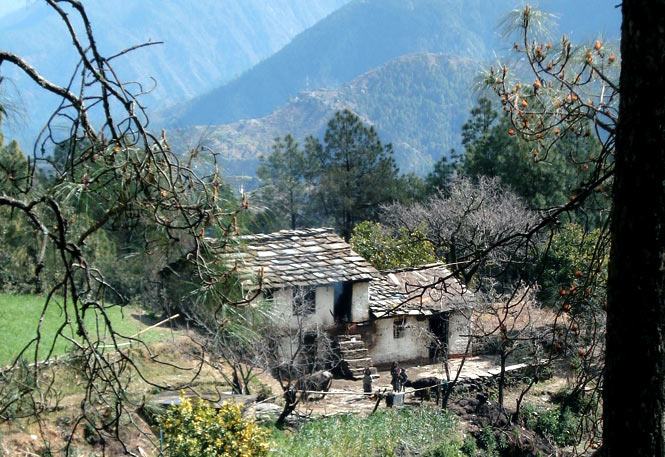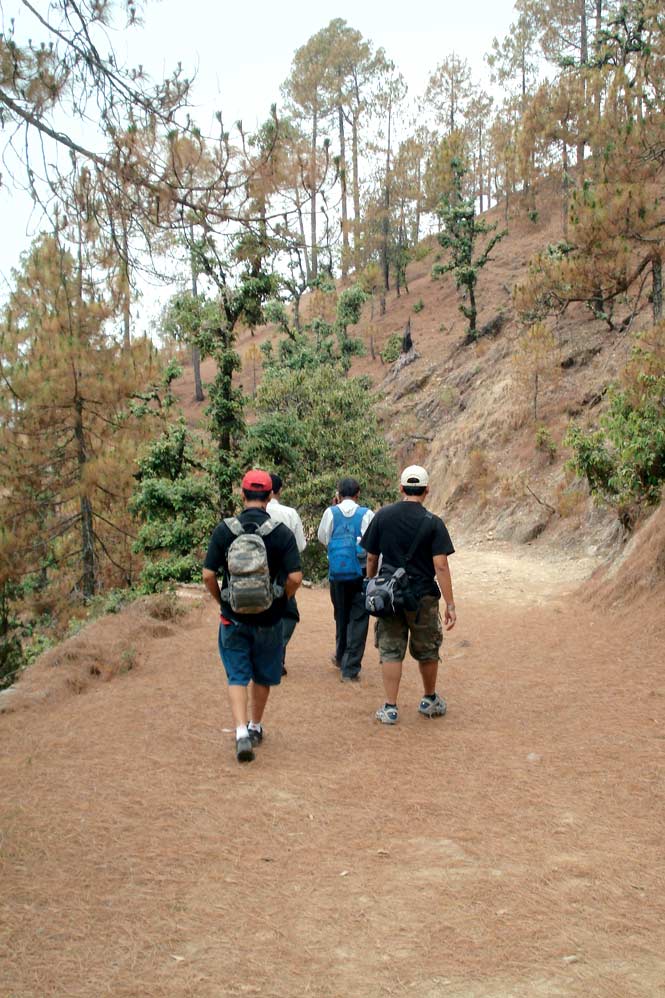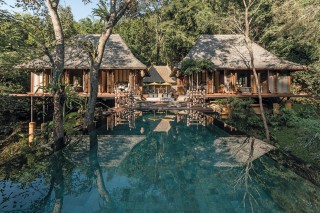Above: a farmhouse in Uttarakhand’s Kumaon district.
Rural tourism is bringing more travelers—and income—to the Kumaon Himalayas
By Jason Overdorf
A few years ago, Satri, a village near Binsar in the Uttarakhand foothills of the Himalayas, was dying. Only three families remained among the abandoned houses, and all the men had gone to nearby towns for work, leaving their mothers and sisters behind. Even the postman hardly bothered to make the hilly, two-hour hike to Satri from the nearest road. Then, one afternoon, an oddball group trooped over the ridge with a bizarre proposal: Tourists who’d never known life without water and electricity and shopping malls, they said, would pay good money to rough it out here and learn about how the villagers lived. It was, the ladies of Satri agreed, a preposterous idea.
But when I marched through the foothills and into Satri at the end of a three-day hike arranged by Village Ways—the oddballs who cooked up the idea of bringing tourists to Satri and other villages in Uttarakhand’s Kumaon district—the place was thriving. The men had come back to work as cooks, guides, and porters, and the women, Satri’s greatest asset, smiled and joked with an easy, outgoing confidence they’ve acquired through hosting foreign visitors.
“It took us around three years to get the villagers to believe in the project. Then they built the guesthouses within a year,” recalls Himanshu Pande, who founded Village Ways with the help of British rural development consultant Keith Virgo.
Money has rolled in, too. Sher Singh, the guide who accompanied me, was there to report that Satri had earned 72,000 rupees (about US$1,490) from tourism over the past two months, a windfall for such a tiny community. Neighboring villages associated with the project had done almost as well.
The reason is simple. Nestled in the shadow of India’s second-highest mountain, Nanda Devi, the area surrounding Binsar offers spectacular beauty. The pine forest is silent and deep; rhododendrons bloom amid the evergreens in a flash of crimson; and, on a clear day, you can see the snowcapped peaks of Nepal and Tibet from the crest of nearly every rise. But the hills seem to grow smaller every year. The once-sleepy hamlets like Bhimtal and Binsar are now filled with cinderblock hotels, guesthouses, and restaurants. Cars and trucks roar up and down the steep curves, and garish signs advertising “multicuisine” restaurants assault from all directions. A good rule of thumb: if you can drive to it, it’s already been ruined. Satri and other nearby villages, which can only be reached on foot due to their location within the Binsar Wildlife Sanctuary, are among the few unspoiled places left.
After waking to a fine breakfast at the Khali Estate, a quaint, comfortable Raj-era resort that acts as a sort of base camp for Village Ways, I set out with Sher Singh—a handsome man with a neat moustache—for our first day of walking. From a sunny spot on the road with a good view of the snowcaps, we dropped quickly down into the dark forest. The ground was springy with moisture, but not wet, and there was an impressive silence. A kilometer or so along, a partridge broke cover and fluttered skyward, the startling whupwhup of its wings setting my heart going at the same rhythm. It was vigorous walking, mostly downhill, and the footing was good. Village Ways spent the better part of a year mapping and building these trails to make them safe and navigable, and to create a network of paths that could facilitate tourists of different fitness levels. “It wasn’t easy to make all these different routes,” Sher Singh told me. “But now we can walk from here to the village in one hour or in four, depending on the guest.”
We stopped at three villages, Kathdhara, Gonap, and Satri, each one smaller and more pleasant than the last. Coming into Kathdhara, we halted on a ridge and looked down over the bright green terraces where the farmers were growing wheat, mustard, lentils, and spinach in oval steps down the hillside. In another 20 minutes, we’d hiked down to the guesthouse, passing great piles of saffron-colored pine needles, stacked like hay to dry for later use as kindling or bedding for livestock. We ate lunch beside a lemon tree with the Pancha Chulli range before us, spent a bit of time chatting with the locals, and then we marched on. In Gonap, we built a bonfire out of football-sized pinecones and watched the sunset, then ate a day laborer’s enormous, starchy meal—dal, aloo gobi, aloo tomatar, flatbread, and rice.
The second day proved to be our longest walk and the most rewarding, because it ended in Satri. It’s no mystery why Satri is everybody’s favorite village. The place only has three families, but they are blessed with beautiful women, all of whom—including a toothless grandma—are constantly smiling and laughing. Before Village Ways started, bringing not only a source of income but also entertainment and a steady train of news and supplies, the few villagers left here thought they would have to abandon their homes and follow their former neighbors to town. Thanks to Pande and his partners at Village Ways, that now looks unlikely to happen.
The key to making the Village Ways project sustainable—that is, to ensuring it remains a going concern without damaging the land or the local culture—was to make the villagers themselves the owners of the guesthouses. Burned once by the state and the forest department when their land was declared part of the Binsar Wildlife Sanctuary, the people here would not have been keen to accept yet another domineering landlord. And the borrow-build-operate model that financed the construction of the guesthouses (Village Ways provided 40 percent of the money with a grant, 60 percent with an interest-free loan, and the villagers did the building) gives them a much deeper commitment to the project than they would have to a hotelier who simply cut them a paycheck.
The local end of management, too, is collaborative. Every village has a democratically elected Gram Paryatan Samiti (village tourism committee), and one member from each of these committees represents the village in a project-wide executive body called the Paryatan Vikas Samiti (tourism development committee), which allocates jobs and makes other essential decisions. The Gram Paryatan Samitis supervised the construction of the five Village Ways guesthouses, which, on the advice of their city-bred collaborators, were built by craftsmen in vernacular style. Assembled from stone and mud mortar, the guesthouses have flush toilets and showers, while solar power provides electricity and hot water. Now, the committees manage the guesthouses’ day-to-day operation and finances—including making payments on the 10-year loan from Village Ways. They also administer a village development fund, which is used to finance projects that will benefit the entire community.
Whether or not Village Ways has provided them with a sustainable future, the villagers appear to welcome the results so far. “Now, at least 25 percent of the migration out has stopped, and the only people who leave are those who get good jobs,” said 78-year-old Amar Singh, a retired policeman who lives in Gonap. “If we continue to get more tourists, we might get a motorable road. We might get more development.”
Of course, it’s the very lack of development that has lured visitors here in the first place, which makes we wonder whether the end result of Village Ways efforts will be to create more cinderblock tourist ghettos like Bhimtal. But on the hike back to Khali Estate, I’m comforted by my recollection of the hospitality in Satri, whose residents clearly share too deep a pride in their traditions and the beauty of their home to allow them to be destroyed. These tiny hamlets may one day find themselves on the electricity grid, and even the road map. But I dare to hope they will retain their charm, and that many, including myself, will still prefer to travel there on foot.
Village Ways (91-1164/623-175; villageways.com) offers 9- to 12-night excursions through Binsar and a newer guesthouse circuit in Saryu Valley from about US$1,028 per person, including meals and train and road transfers from Delhi. Shorter itineraries and tailor-made packages are also available.
Originally appeared in the August/September 2009 print issue of DestinAsian magazine ( “It Takes a Village”)










